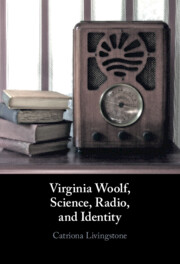33 results
Chapter 28 - Working with the BBC
- from Part V - Institutions
-
-
- Book:
- Vaughan Williams in Context
- Published online:
- 28 March 2024
- Print publication:
- 04 April 2024, pp 239-248
-
- Chapter
- Export citation
Chapter 18 - War
- from Part III - Culture and Society
-
-
- Book:
- Vaughan Williams in Context
- Published online:
- 28 March 2024
- Print publication:
- 04 April 2024, pp 151-158
-
- Chapter
- Export citation
6 - ‘Western Civilisation’ and Applied Science
- from Stage 2 - Research in the Early Twentieth Century
-
- Book:
- Applied Science
- Published online:
- 15 March 2024
- Print publication:
- 28 March 2024, pp 166-192
-
- Chapter
- Export citation
Chapter 6 - Literature and the Technologies of Radio and Television
- from Part II - Infrastructures
-
-
- Book:
- Technology in Irish Literature and Culture
- Published online:
- 19 January 2023
- Print publication:
- 26 January 2023, pp 99-117
-
- Chapter
- Export citation
Chapter 14 - New Traditions
-
-
- Book:
- A History of Welsh Music
- Published online:
- 08 September 2022
- Print publication:
- 29 September 2022, pp 315-331
-
- Chapter
- Export citation
Chapter 16 - Postscript
-
-
- Book:
- A History of Welsh Music
- Published online:
- 08 September 2022
- Print publication:
- 29 September 2022, pp 355-365
-
- Chapter
- Export citation
Chapter 13 - Traditions and Interventions
-
-
- Book:
- A History of Welsh Music
- Published online:
- 08 September 2022
- Print publication:
- 29 September 2022, pp 291-314
-
- Chapter
- Export citation
Conclusion: Unsuitable for Children
-
- Book:
- Adventures in Childhood
- Published online:
- 30 June 2022
- Print publication:
- 14 July 2022, pp 281-292
-
- Chapter
- Export citation
6 - The Rise of Merchandising Agencies
-
- Book:
- Adventures in Childhood
- Published online:
- 30 June 2022
- Print publication:
- 14 July 2022, pp 189-236
-
- Chapter
- Export citation
11 - The Historical Context in Media Narratives in Search of Peaceful Resolution to the Israel–Palestine Conflict
- from Part III - Media Discourse and Conflict Resolution
-
-
- Book:
- Discourse, Media, and Conflict
- Published online:
- 21 April 2022
- Print publication:
- 28 April 2022, pp 257-277
-
- Chapter
- Export citation
Chapter 10 - Recording a Musical Experience: Britten’s Works on Record and Television
- from Part II - British Musical Life
-
-
- Book:
- Benjamin Britten in Context
- Published online:
- 31 March 2022
- Print publication:
- 21 April 2022, pp 86-94
-
- Chapter
- Export citation
Chapter 9 - Britten and the Radio
- from Part II - British Musical Life
-
-
- Book:
- Benjamin Britten in Context
- Published online:
- 31 March 2022
- Print publication:
- 21 April 2022, pp 78-85
-
- Chapter
- Export citation
Chapter 7 - Composing in England
- from Part II - British Musical Life
-
-
- Book:
- Benjamin Britten in Context
- Published online:
- 31 March 2022
- Print publication:
- 21 April 2022, pp 63-70
-
- Chapter
- Export citation
Chapter 25 - Eric Crozier
- from Part IV - Wordsmiths, Designers, and Performers
-
-
- Book:
- Benjamin Britten in Context
- Published online:
- 31 March 2022
- Print publication:
- 21 April 2022, pp 223-231
-
- Chapter
- Export citation
Chapter 38 - Faith, Spirituality, and the Church
- from Part V - British Sociocultural, Religious, and Political Life
-
-
- Book:
- Benjamin Britten in Context
- Published online:
- 31 March 2022
- Print publication:
- 21 April 2022, pp 334-342
-
- Chapter
- Export citation
Chapter 3 - ‘Our Senses Have Widened’
-
- Book:
- Virginia Woolf, Science, Radio, and Identity
- Published online:
- 10 February 2022
- Print publication:
- 17 February 2022, pp 117-150
-
- Chapter
- Export citation

Virginia Woolf, Science, Radio, and Identity
-
- Published online:
- 10 February 2022
- Print publication:
- 17 February 2022
10 - The Public Media Option
- from Part V - The Role of Public Broadcasting
-
-
- Book:
- The Disinformation Age
- Published online:
- 06 October 2020
- Print publication:
- 15 October 2020, pp 238-258
-
- Chapter
-
- You have access
- Open access
- HTML
- Export citation
Chapter 16 - Wireless Imaginations
- from Part III - Applications
-
-
- Book:
- Sound and Literature
- Published online:
- 29 May 2020
- Print publication:
- 18 June 2020, pp 334-350
-
- Chapter
- Export citation
6 - Case Studies
-
- Book:
- Innovations in Shipping
- Published online:
- 19 March 2020
- Print publication:
- 16 April 2020, pp 117-180
-
- Chapter
- Export citation



